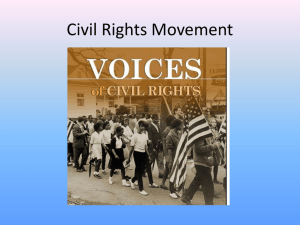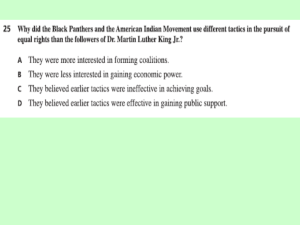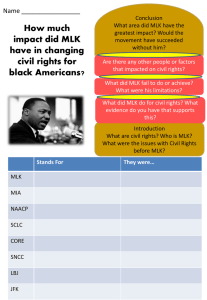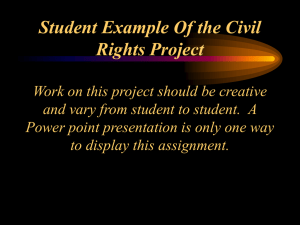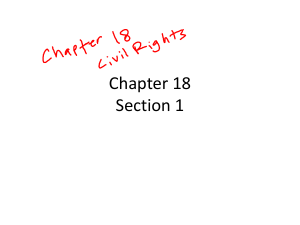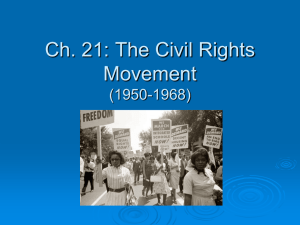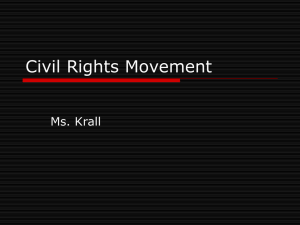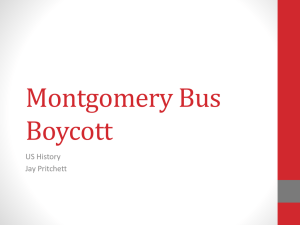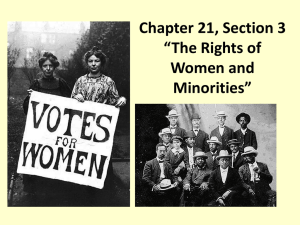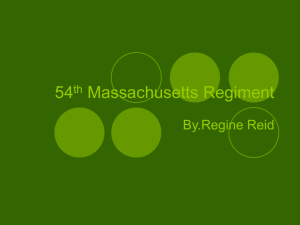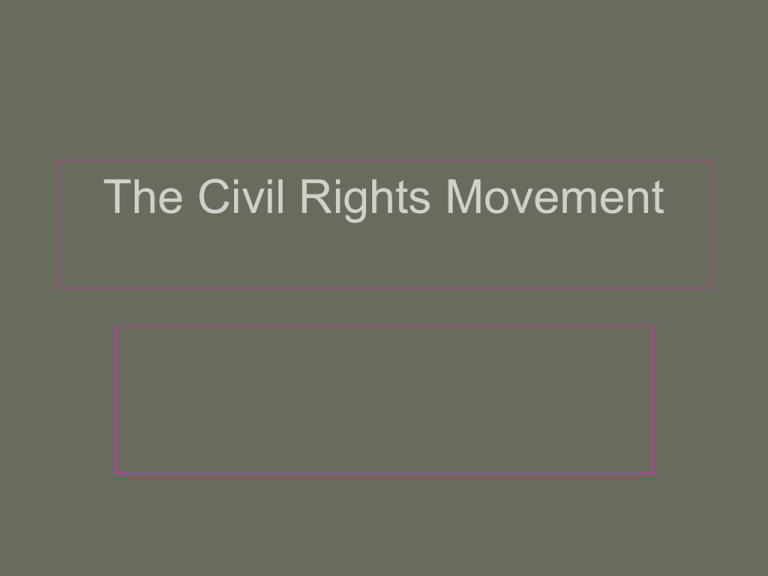
The Civil Rights Movement
Fighting Segregation
The Main Idea
In the mid-1900s, the civil rights movement began to make
major progress in correcting the national problem of racial
segregation.
Reading Focus
• What was the status of the civil rights
movement prior to 1954?
• What were the key issues in the Supreme
Court’s ruling in Brown v. Board of Education of
Topeka, Kansas, and what was its impact?
• How did events in Montgomery, Alabama, help
launch the modern civil rights movement?
The Civil Rights Movement prior to 1954
To 1940
To 1930
Pre-1900
• A. Philip
• Booker T.
• Opposition to
Randolph forced
Washington and
slavery in
a federal ban
W.E.B. Du Bois
colonial days
against
• Founding of the
discrimination in
• Abolition
NAACP in 1909
defense work.
movement and
Civil War
• African
• 1940s founding
Americans
of CORE
• Legalized
suffered worse
racism after
• President
than others
Reconstruction
Truman
during the Great
desegregated
• 1896 Plessy v.
Depression.
the armed
Ferguson
• Roosevelt
forces.
allowed the
unwilling to push
segregation of
• Brooklyn
too hard for
African
Dodgers put an
greater African
Americans and
African
American rights.
whites.
American—
Jackie
What is Jim Crow?
• Laws passed from 18771954 that LEGALLY
discriminated against
black people
• Examples: separate
schools, bathrooms,
drinking fountains, voting
laws
• Basically, allowing
African Americans to be
treated as 2nd class
citizens
Voting Restrictions
•
Southern states
passed laws to make
sure African American
could not vote in large
numbers
1. Poll taxes
2. Literacy Tests
3. Grandfather Clauses
RACIAL VIOLENCE
LYNCHING
• 1882-92: c. 1,200 African
Americans lynched
• LYNCHING- being killed
usually by mobs for a
“suspected” crime without a
proper trial
• Most in the South- most
were never
arrested/punished
PLESSY v FERGUSON
• 1896 Supreme Court
Decision that made
Segregation legal in
the South
• “SEPARATE BUT
EQUAL” will be the
law in the South until
the 1954 Brown v.
Board of Education
Case
NAACP
(National Association for the Advancement of
Colored People)
• Created in 1910 to “chip”
away the LEGALITY of
Segregation
• Long, expensive battle to
prove that conditions
were not equal
• Try to prove violations in
14th Amendment
Brown v. Board of Education
of Topeka, Kansas-1954
• In a bold move, NAACP
found one case to try to end
Jim Crow /Segregation
• NAACP proved that the
condition of 12 yr. old Linda
Brown were not equal
• Brown v. Board overruled
Plessy v. Ferguson
Brown v. Board of Education
The Supreme Court heard arguments over a two-year
period. The Court also considered research about
segregation’s effects on African American children.
In 1954 Chief Justice Earl Warren issued the Supreme
Court’s decision.
All nine justices agreed that separate schools for African
Americans and whites violated the Constitution’s
guarantee of equal protection of the law.
The Emmitt Till Case
BEFORE
•Boy from Chicago
•Visiting family in
Mississippi
•Spoke to a white
lady
•Got lynchedbody mutilated
and thrown in
water
•Murderers were
acquitted
•Showed America
how racist the
south was.
AFTER
Montgomery, Alabama Bus
Boycott-1955
• ROSA PARKS refused to
give up seat on bus
• Montgomery blacks begin 1
year boycott
• Martin Luther King Jr. (MLK)
emerges as young civil rights
leader
• Busses are eventually
desegregated.
• 1st major civil rights victory
The Montgomery Bus Boycott
• When Rosa Parks was arrested, the NAACP called for a one-day
boycott of the city bus system.
• Community leaders formed the Montgomery Improvement
Association and selected Martin Luther King Jr. as its leader.
• African Americans continued to boycott the bus system for a
year—which hurt the bus system and other white businesses.
• After the Supreme Court ruled that segregation on buses was
unconstitutional, integration of the buses moved forward.
The Little Rock 9- 1957
• 9 black students sent to Little Rock Central High
School to test the Brown Decision
• Protests and death threats erupted on 1st day
• The school board attempted to close down the school
Little Rock 9 (cont)
• Arkansas Governor
Orville Faubus rejected
integration and sent in
State troops to block the
black students
• In bold move, President
Eisenhower sent in
Federal troops to escort
students through school
Little Rock 9 (cont)
• The events in Little Rock
demonstrated the same
dilemma that existed
during the Civil War 100
years earlier…
• STATES RIGHTS
versus FEDERAL
POWER- who should
have power??
Civil Rights Strategies of
Nonviolence
• NONVIOLENT RESISTANCE: those who carry out
demonstrations should never use violence
• CIVIL DISOBEDIENCE: nonviolently breaking unjust
laws; getting arrested for a cause
• Ideas were used successfully by Gandhi in India to
free India from British oppression- now used by
•
MLK in America
New Organizations Formed to
Fight for Civil Rights
• 1957-SCLCSouthern Christian
Leadership
Conference
• Nonviolent group
founded by MLK
and southern
ministers
• 1960- SNCC- Student
Nonviolent Coordinating
Committee “Snick”
• Started out as College
students
• Traveled country staging
demonstrations
• Used Civil Disobedience
• “Jail not Bail”
• More radical than SCLC
SIT-INS (1960)
• Using Civil
Disobedience, activists
attempted to integrate
lunch counters
throughout the South
• Strategy was to politely
sit at counters and get
arrested (jail not bail)
• In 5 days, Sit-ins grew
from 4 to 300 people in
North Carolina
• SPREAD
THROUGHOUT THE
NATION
John F. Kennedy (1961-1963)
JFK and Civil Rights
• JFK wins 1960
Presidency in a slim
margin (120,000 votes)
with promise to help the
cause of civil rights
• BUT was afraid to act
powerfully
• 3 separate events would
force JFK to take a stand
FREEDOM RIDES (1961)
• In 1961, Federal
Government integrated
interstate travel and
integrated bus stops, train
stations. Airports
• Civil Rights leaders wanted
to test new freedoms
• Black and white activists
rode through the South on
buses together
• Buses were bombed
• Riders were beaten
• Ala. Governor Patterson
refused to protect riders
• JFK SENT IN NATIONAL
GUARD
Results of Sit-ins and Freedom Rides
• Succeeded at getting businesses to change their
policies
Sit-ins • Marked a shift in the civil rights movement—
showed young African Americans’ growing
impatience with the slow pace of change
• Leaders formed the SNCC.
Freedom • After the savage beatings in Birmingham,
bus companies refused to sell the Freedom
Rides
Riders tickets and CORE disbanded the
Freedom Ride.
• SNCC continued the Freedom Rides.
Federal
Intervention • Attorney General Robert Kennedy sent federal
marshals to Montgomery to protect the riders.
• The Interstate Commerce Commission finally
forced the integration of bus and train stations.
BIRMINGHAM
DEMONSTRATIONS
(Spring 1963)
• Birmingham, Alabama- 40%
black- city with a racist tradition
• Civil Rights activists assemble
here
• Chief of police, “Bull” Conner
orders dogs and fire hoses
turned on the demonstratorseven kids
• MLK almost killed- MLK
declares Birmingham as most
important battle yet b/c
broadcast all over the world
• MEDIA VICTORY
Impact of Birmingham
• Birmingham
demonstrations
forced JFK to
propose Civil
Rights Act
• Wasn’t passed until
after JFK
assassinated
• DID NOT include
voting power
The March on Washington
• Summer, 1963- not long
after Birmingham
• 200,000 African
Americans converged on
Washington DC to push
the Government into
acting on civil rights
• MLK delivers famous
speech which steals the
show
• JFK understands that
Civil Rights act must
happen
CIVIL RIGHTS ACT 1964
•
•
Proposed by JFK, passed
by LBJ
Overcame a filibuster
– PROVISIONS
1. Prohibits discrimination in
public places
2. Gov’t can withhold federal
money if states violate the act
3. Prohibits discrimination based
on race, religion, sex, or
national origin by an employer
•
Did not include voting rights
Civil Rights Act of 1964
President
Kennedy
Medgar
Evers
•
The events in Alabama convinced President Kennedy to
act on civil rights issues.
•
Kennedy announced that he would ask for legislation to
finally end segregation in public accommodations.
•
Medgar Evers, the head of the NAACP in Mississippi,
was shot dead in his front yard.
•
Ku Klux Klan member Byron De La Beckwith was tried for
the crime but all-white juries failed to convict.
•
On August 28, 1963, the largest civil rights
demonstration ever held in the United States took place
in Washington.
March
on
•
Washington
More than 200,000 people marched and listened to
Martin Luther King Jr.’s “I Have a Dream” speech.
The Triumph
of Civil Rights
2. Selma, Alabama
• There was still no leg. Enforcing
the 15th Amendment; MLK
targeted Selma, AL next
• MLK used TV, newspapers to
highlight discrim.; Selma Sher.
Jim Clark rivaled Bull Connor
• After 2 months of beatings,
arrests and a murder, a 54 mi.
march to Montgomery, AL was
planned
• Gov. George Wallace banned
the march, but organizers
marched anyway
The Triumph
of Civil Rights
2. Selma, Alabama
• On the way, marchers were
turned back by state troopers
on the Edmund Pettus Bridge
with tear gas and clubs
• Awaiting on the other side
was Sheriff Clark’s deputies;
violence ensued
• MLK led a 2nd march to the
bridge, led prayer midway
across, surprisingly turned
around… the public, LBJ
again supported MLK
• LBJ introduced leg. to protect
Afr. Am. voter rights
•
VOTING RIGHTS ACT OF
1965
LBJ proposed
– Provisions
1. Allowed African
Americans to freely
register to vote
2. Outlawed literacy tests
and other southern
restrictions to voting
The Voting Rights Act
Selma Campaign
Selma March
• King organized
• 600 African
marches in
Americans
Selma, Alabama,
began the 54to gain voting
mile march.
rights for African
• City and state
Americans.
police blocked
• King and many
their way out of
other marchers
Selma.
were jailed.
• TV cameras
• Police attacked a
captured the
march in Marion.
police using
clubs, chains,
• King announced a
and electric
four-day march
cattle prods on
from Selma to
the marchers.
Montgomery.
Voting Rights
Act
• President
Johnson asked
for and
received a
tough voting
rights law.
• The Voting
Rights Act of
1965 passed in
Congress with
large
majorities.
• Proved to be
one of the
most important
pieces of civil
rights
legislation ever
passed.
24th AMENDMENT TO THE
US CONSTITUTION-1964
• BANNED POLL
TAXES
Disappointed Hopes
•
•
While the movement was
successful in getting legal
equality, racism continues
to exist.
Many people were
becoming MARTYRS for
the cause of Civil Rights
1.
2.
3.
4.
•
4 girls in Birmingham
Civil rights workers in Miss
Malcolm X- killed in 1965
MLK killed in 1968
People began QuestioningWas it worth it? Was
strategy working?
Fractures in the Movement Black Muslims
Black Power
Black Panthers
• Nation of Islam
• The Black Panther
was a large and
• Stokely
Party was formed in
influential group
Carmichael
Oakland, California,
who believed in
became the head
in 1966.
Black Power.
of SNCC.
• Called for violent
revolution as a
• Message of
• SNCC abandoned
means of African
black
the philosophy of
American liberation.
nationalism,
nonviolence.
• Members carried
self-discipline,
guns and monitored
• Black Power
and selfAfrican American
became the new
neighborhoods to
reliance.
rallying cry.
guard against police
• Malcolm X
brutality.
• Wanted African
offered message
Americans to
of hope,
depend on
defiance, and
themselves to
black pride.
The Death of Martin Luther King Jr.
King became aware that economic issues must be part of
the civil rights movement.
King went to Memphis, Tennessee to help striking
sanitation workers. He led a march to city hall.
James Earl Ray shot and killed King as he stood on the
balcony of his motel.
Within hours, rioting erupted in more than 120 cities.
Within three weeks, 46 people were dead, some 2,600
were injured, and more than 21,000 were arrested.
New Directions
• Black SeparatismAfrican Americans that
actually wanted to
separate from white
culture
• Black Pride- Pride in
being black
• Black Power-attempt to
seize political power
without the help of white
America
MALCOLM X
• Black separatist who
embraced Islam
– NATION OF ISLAMAmerican black Muslim
movement that followed the
teaching of Muhammad
• Malcolm was more radical
and more threatening to
whites than MLK
• Assassinated in 1965
CHAOS in the late 1960’s
• Long. Hot, Summers angry blacks rioted in
many American cities in
late 1960’s (most
famous is Watts- LA
ghetto)
• MLK assassinated in
1968
• RFK- Bobby Kennedy
assassinated in 1968

